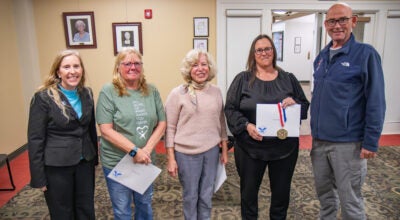FAKING FOR THE FUTURE: Full-scale tornado drill puts emergency plan into action, sharpens first responders’ skills
Published 12:48 pm Monday, September 5, 2016

- Photo by Abigail Whitehouse First responders from Lincoln and surrounding counties and local students participate in a full-scale tornado exercise at the Lincoln County Fairgrounds.
STANFORD – An F2 tornado didn’t actually touch down at the Lincoln County Fairgrounds last week, but the coordinated scene of destruction, debris and “injured” victims gave first responders an opportunity to test their skills and sharpen their response to an emergency that could occur in the future.
Lincoln County High School students from Dana Moore’s Health and Sciences class were scattered across the fairgrounds as they played the role of victim during the Aug. 25 tornado exercise.
Injuries of the “victims” ranged from minor bleeds to life-threatening trauma, giving emergency responders plenty of practice as they located, triaged and transported students from the scene to Fort Logan Hospital in Stanford.
The F2 tornado scenario at the fairgrounds was an exercise aimed at testing multi-agency responses and first responders’ ability to identify and respond to other threats on scene, demonstrate the triage, packaging and transportation of multiple victims, develop functional relationships with media resources and prepare a working disaster plan for future fairground responses.
Responders from multiple counties hustled across the fairgrounds for about two-and-a-half hours last Thursday as they assessed structural damage to buildings, cleared scattered debris and located missing victims.
It was about noon before the large group of emergency professionals wrapped up the exercise and gathered out of the heat to eat a lunch provided by the Lincoln County Cattlemen’s Association and to discuss the exercise, mistakes that were made and recommendations for future response to similar scenarios.
Emergency Management Director Don Gilliam said the exercise aims to increase awareness of risks related to the fairgrounds and produce recommendations for future preparedness plans.
According to Gilliam, the Lincoln Fair complex is vulnerable to a variety of natural hazards that threaten life and property including earthquakes, floods, ice storms, landslides, thunderstorms and of course, tornados.
In addition to responding to the particulars of the tornado exercise, there are several shared characteristics of most crisis situations such as crowd control, internal conflict and confusion, intense media scrutiny, panic and government involvement.
The critique that followed the exercise Thursday pointed out a few deficiencies related to communication during the event.
“I realize some of the problems today were caused by designating different agencies to go to a particular channel and so therefore some of them did not always get the commands,” Gilliam said. “That’s why we do this, so we can work on those problems. During an actual event, there needs to be staffing of a unified command center. I think that went pretty well today.”
Gilliam also discussed how the media and public, such as parents responding to the scene, would be handled during an actual event.
“In this type of event, we would have a designated area for the media and for parents responding to the scene or bystanders,” he said.
While there is a tentative emergency action plan for the fairgrounds, Gilliam said emergency management plans to provide an updated version to the fair board.
“There is (one) but as far as it related to emergency response, that is something we have talked about for the last year,” he said. “That’s the purpose of this. After this we are going to sit down and we are going to develop an emergency action plan for the fairgrounds that we will give to them.”
Lincoln County EMS Director Ashley Powell said he was pleased with the EMS response during the exercise but was able to identify a few areas of improvement as far as triaging patients.
“We tried a new system this year and it does need a little tweaking,” Powell said. “We got a grant for a mass casualty trailer, which was utilized today.”
EMS personnel used color-coded flags to determine the extent of injuries to victims with red signifying a severe injury and black signifying death.
“I think EMS did a really great job,” Powell said. “Every exercise we do in this county we learn something from and I think we learned a lot from this one.”
Moore said the tornado provided more than 30 students with a taste of real emergency medical response.
“My students learn from this. They learn a lot about their careers,” Moore said. “Many of them want to go into healthcare but they’re not sure why and hopefully this will help. You all do such a great job, this is going to be presented in October to a national health science teachers’ conference.”
Moore said many schools and communities don’t do mock disasters so she plans to share the hard work of Lincoln County emergency management on a national level to help develop similar exercises and help other communities get involved.





